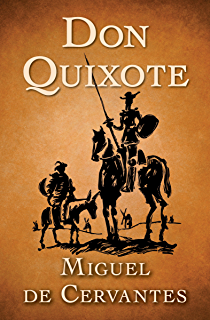 Don Quixote de la Mancha
Don Quixote de la Mancha
is a novel written by Miguel de Cervantes, the great Spanish writer. The first part was published under the name "El ingenioso hidalgo don Quijote de la Mancha" at the beginning of 1605, and it's considered one of the great literary works of the Spanish and universal literature, as well as one of the most translated.
Don Quixote is considered one of the most influential works of literature from the Spanish Golden Age and the entire Spanish literary canon. As a founding work of modern Western literature and one of the earliest canonical novels, it regularly appears high on lists of the greatest works of fiction ever published, such as the Bokklubben World Library collection that cites Don Quixote as authors' choice for the "best literary work ever written".
The story follows the adventures of a hidalgo named Mr. Alonso Quixano who reads so many chivalric romances that he loses his sanity and decides to set out to revive chivalry, undo wrongs, and bring justice to the world, under the name Don Quixote de la Mancha. He recruits a simple farmer, Sancho Panza, as his squire, who often employs a unique, earthy wit in dealing with Don Quixote's rhetorical orations on antiquated knighthood. Don Quixote, in the first part of the book, does not see the world for what it is and prefers to imagine that he is living out a knightly story. Throughout the novel, Cervantes uses such literary techniques as realism, metatheatre, and intertextuality. It had a major influence on the literary community, as evidenced by direct references in Alexandre Dumas' The Three Musketeers (1844), Mark Twain's Adventures of Huckleberry Finn (1884) and Edmond Rostand's Cyrano de Bergerac (1897), as well as the word "quixotic". Arthur Schopenhauer cited Don Quixote as one of the four greatest novels ever written.
In 1614 someone published a second part to Don Quixote, signing it with the name Alonso Fernández de Avellaneda (his real identity remains a mystery). In the prologue to this book, the writer accuses Cervantes of being jealous of Félix Lope de Vega's success as a play writer. Although the sequel is good for an imitator, it can't really compare to Cervantes' version.
In 1615 the second "real" book was published under the title "El ingenioso caballero don Quijote de la Mancha" by Cervantes. In the prologue, the writer defends himself from the accusations received from the unknown Avellaneda, and laments on the difficulties of being a writer. In this novel, the writer plays with different planes of reality by including, in this second part, mentions to the first part of the novel and to the false second part, which Don Quixote and Sancho have read.
Summary
Alonso Quixano, the protagonist of the novel (though he is not given this name until much later in the book), is a Hidalgo (member of the lesser Spanish nobility), nearing 50 years of age, living in an unnamed section of La Mancha with his niece and housekeeper, as well as a boy who is never heard of again after the first chapter. Although Quixano is usually a rational man, his reading in excess books of chivalry has produced the distortion of his perception and the wavering of his mental faculties. In keeping with the humoral theory of the time, not sleeping adequately - because he was reading - has caused his brain to dry; Quixano's temperament is thus choleric, the hot and dry humor. As a result, he is easily given to anger and believes every word of these fictional books of chivalry to be true.
Imitating the protagonists of these books, he decides to become a knight-errant in search of adventure. To these ends, he dons an old suit of armour, renames himself "Don Quixote", names his exhausted horse "Rocinante", and designates Aldonza Lorenzo, a neighboring farm girl, as his lady love, renaming her Dulcinea del Toboso, while she knows nothing of this. Expecting to become famous quickly, he arrives at an inn, which he believes to be a castle; calls the prostitutes he meets "ladies" (doncellas); and asks the innkeeper, whom he takes as the lord of the castle, to dub him a knight. He spends the night holding vigil over his armor and becomes involved in a fight with muleteers who try to remove his armor from the horse trough so that they can water their mules. In a pretended ceremony, the innkeeper dubs him a knight to be rid of him, and sends him on his way.
Don Quixote next "frees" a young boy tied to a tree and beaten by his master, and makes his master swear to treat the boy fairly; but the boy's beating is continued as soon as Quixote leaves. Don Quixote then encounters traders from Toledo, who "insult" the imaginary Dulcinea. He attacks them, only to be severely beaten and left on the side of the road, and returned to his home by a neighbouring peasant.

Plot Overview
Don Quixote is a middle-aged gentleman from the region of La Mancha in central Spain. Obsessed with the chivalrous ideals touted in books he has read, he decides to take up his lance and sword to defend the helpless and destroy the wicked. After a first failed adventure, he sets out on a second one with a somewhat befuddled labourer named Sancho Panza, whom he has persuaded to accompany him as his faithful squire. In return for Sancho's services, Don Quixote promises to make Sancho the wealthy governor of an isle. On his horse, Rocinante, a barn nag well past his prime, Don Quixote rides the roads of Spain in search of glory and grand adventure. He gives up food, shelter, and comfort, all in the name of a peasant woman, Dulcinea del Toboso, whom he envisions as a princess.
The story of Don Quixote’s deeds includes the stories of those he meets on his journey. Don Quixote witnesses the funeral of a student who dies as a result of his love for a disdainful lady turned shepherdess. He frees a wicked and devious galley slave, Gines de Pasamonte, and unwittingly reunites two bereaved couples, Cardenio and Lucinda, and Ferdinand and Dorothea. Torn apart by Ferdinand’s treachery, the four lovers finally come together at an inn where Don Quixote sleeps, dreaming that he is battling a giant.
Along the way, the simple Sancho plays the straight man to Don Quixote, trying his best to correct his master’s outlandish fantasies. Two of Don Quixote’s friends, the priest and the barber, come to drag him home. Believing that he is under the force of an enchantment, he accompanies them, thus ending his second expedition and the First Part of the novel.
The Second Part of the novel begins with a passionate invective against a phony sequel of Don Quixote that was published in the interim between Cervantes’s two parts. Everywhere Don Quixote goes, his reputation - gleaned by others from both the real and the false versions of the story - precedes him.
On his second expedition, Don Quixote becomes more of a bandit than a savior, stealing from and hurting baffled and justifiably angry citizens while acting out against what he perceives as threats to his knighthood or to the world. Don Quixote abandons a boy, leaving him in the hands of an evil farmer simply because the farmer swears an oath that he will not harm the boy. He steals a barber's basin that he believes to be the mythic Mambrino's helmet, and he becomes convinced of the healing powers of the Balsam of Fierbras, an elixir that makes him so ill that, by comparison, he later feels healed. Sancho stands by Don Quixote, often bearing the brunt of the punishments that arise from Don Quixote's behavior.
As the two embark on their journey, Sancho lies to Don Quixote, telling him that an evil enchanter has transformed Dulcinea into a peasant girl. Undoing this enchantment, in which even Sancho comes to believe, becomes Don Quixote’s chief goal.
Don Quixote meets a Duke and Duchess who conspire to play tricks on him. They make a servant dress up as Merlin, for example, and tell Don Quixote that Dulcinea’s enchantment - which they know to be a hoax - can be undone only if Sancho whips himself 3,300 times on his naked backside. Under the watch of the Duke and Duchess, Don Quixote and Sancho undertake several adventures. They set out on a flying wooden horse, hoping to slay a giant who has turned a princess and her lover into metal figurines and bearded the princess’s female servants.
During his stay with the Duke, Sancho becomes governor of a fictitious isle. He rules for ten days until he is wounded in an onslaught the Duke and Duchess sponsor for their entertainment. Sancho reasons that it is better to be a happy laborer than a miserable governor.
A young maid at the Duchess’s home falls in love with Don Quixote, but he remains a staunch worshipper of Dulcinea. Their never-consummated affair amuses the court to no end. Finally, Don Quixote sets out again on his journey, but his demise comes quickly. Shortly after his arrival in Barcelona, the Knight of the White Moon - actually an old friend in disguise - vanquishes him.

